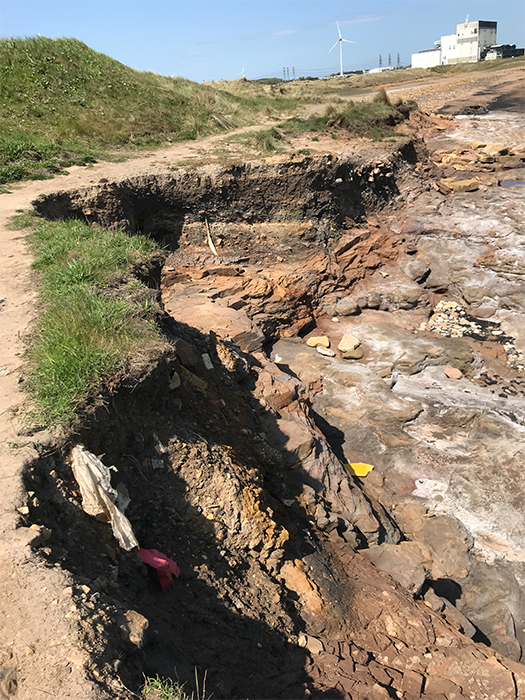Many environmental campaigns draw attention to the problems that are in plain view: rubbish on beaches entering our seas, plastic drinks stirrers, bags and bottles; the food, energy, and paper wasted in offices and schools. At A Future Without Rubbish (AFWR), we focus on viable solutions to these problems as a key part of our success.
Our current Coastline Runner initiative is one such example. As part of this initiative, we advise councils, landlords and The Crown Estate (which manages almost half over of our country’s foreshores) on how they might systemically start reducing the plastic pollution in our oceans. Many are fruitfully engaged with this challenge.
However, another very significant threat to environmental and public health is out of view – that is, until it is released, or until it harms or even kills wildlife. Historic landfills – the dumping grounds for household and industrial waste since the 1900s – have the potential to release many tonnes of pollution into waterways and seas, which could render attempts to reduce plastic pollution along the UK's coasts almost insignificant. The Crown Estate is responsible for many sites in Norfolk alone, which will soon pose a risk. The Estate has now begun a thorough risk analysis, which is laudable.
Landfills that are operational now are both licenced and regulated. However, those that are dormant and unused – known as ‘historic’ or ‘legacy landfills’ – are a different matter. Given how long they have been a repository for the detritus of modern living, very little detail is known about what they contain, and what kinds of chemicals and gases they have generated and accumulated over time. At first glance, legacy landfills may not seem like a huge problem: if they have lain there so long, why do their contents pose a threat now?
The answer is in the location. Of the 23,000+ known historic landfills in the UK, a large number are found in coastal areas and along riverbanks. Many were placed close to these waterways by design: it was hoped that, over time, any toxic elements in these landfills would be diluted and dispersed by soil and water, using nature as an 'impact attentuator', and that processes would eventually render any toxic elements insignificant. However, just as we have become more aware of both the longevity and harm of many disposed-of substances, climate change has supercharged the risk of their release into the environment. Rising sea levels, coastal erosion, heavier rainfall and increased flooding means that the contents of some landfills in the UK have already been exposed (see below). According to the University of Plymouth, 28 per cent of the English and Welsh coastline is experiencing erosion of more than 10 cm per year, and predictions by Climate Central show that by 2040, Hull and Skegness will be below annual flood levels, as will parts of Blackpool, Peterborough and Lincoln. That’s just 16 years from now.
A worrying number of historic landfills are already exposed and leaching. I witnessed these myself in Suffolk in May 2024, as part of the Coastline Runner initiative, and last year in Lincolnshire and Northumberland. The pollution directly around the historic landfills is shocking, especially where they are situated along relatively unpolluted coastlines.
 |
|
A leaching legacy landfill on Northumberland Coast. © Luke Douglas-Home CEnv
The exact contents of these landfills are unknown, but the assumption is that many will contain toxic substances, such as asbestos, mercury, PVC, acids, lead, home cleaning chemicals, and even radioactive material. Even those that do not contain overtly toxic substances can have high levels of metals and chemicals, from the breakdown of the complex plastics and electronics that they contain. In 1999, the EU’s Landfill Directive (enshrined in UK law in 2001) ensured that new waste disposal practices were controlled and monitored. Prior to this, although a regime was in place to licence and categorise the waste in landfills, little was done to mitigate the potential environmental and public health risks. For example, leachate containment was not required, so the landfill contents could (and still do) leach freely into the surrounding soil and groundwater.
Environmental & economic harm
The risks of some of these chemicals entering the environment has become clearer more recently. In the autumn of 2021, along a 70 km coastline from Seaham in County Durham to Robin Hood’s Bay in North Yorkshire, thousands of crabs washed up on the shore, either twitching and dying, or already dead. Scientists commissioned by local fishing businesses reported that pyridine, a toxic solvent used in medicines and paint, was found in the crustaceans and it was suggested that this chemical was responsible for the deaths. The cause was speculated to be dredging to make way for a new superport in the Tees, which had involved depositing 250,000 tonnes of sediment two miles out to sea, although investigations by Defra into the deaths have not been able to determine the definite cause. The prawn fleet in Hartlepool subsequently suffered dire returns, and no crabs have been found in the die-off zone since the first mass deaths, destroying the livelihoods of the local fishermen and affecting the businesses they supply in Teesside and beyond.
 |
© Frerk Meyer | Flickr
Public harm
It is well known that gases are generated in closed landfills. When bacteria break down organic waste, 90 per cent of the gases they produce are methane and carbon dioxide. While methane has a relatively shorter lifespan in the atmosphere than CO2, it is a significant GHG, as it traps more heat. Other complex gases are also generated that can be highly toxic, and lethal to humans.
This was tragically illustrated in 2014, when a seven-year-old boy, Zane Gbangbola, died when his home in Chertsey was flooded. A 2016 inquest found the cause of death to be carbon monoxide poisoning from a petrol pump bought to clear floodwater from his home. This was disputed by his parents as this as the pump was never turned on, and, on the night of the tragedy, high levels of hydrogen cyanide (HCN) were detected by the fire services (who immediately evacuated neighbours). It now appears more likely that Zane died after floodwater passing through a former landfill site carried HCN into the family’s home. Zane’s father, Kye Gbangbola, remains paralysed following the incident, and the couple have since left their home: the nearby historic landfill was still deemed unsafe. Members of Parliament are now backing a call for an independent panel inquiry into what happened.
 |
Seven-year-old Zane Gbangbola © Nicole Lawler
So, what is being done? Useful research has been conducted to identify both the most vulnerable coastal areas, and to assess the levels of pollution risk in the surroundings of individual sites. Once AFWR had made The Crown Estate aware of the number of exposed landfills near the shorelines and waterways, they commissioned us to identify risks and advise on steps to mitigate the threat to environmental and public health.
After awareness, is complete inaction illegal?
Remediation of landfill sites is expensive, and is therefore low on councils’ immediate actions list. However, the adoption of the precautionary principle in all policies by the UK Government in 2022 emphasises the need for proactive measures to prevent environmental harm, even when it is not fully established scientifically that there is a risk. Encouragingly, several councils want to work to get ahead of the problem. In February 2024, Lewes District Council voted unanimously to introduce proposals under ‘Zane’s Law’, to ensure that all relevant councils keep a local register of potentially contaminated land and to advocate for a full, publicly available national register to be compiled by the Environment Agency. Four councils have followed suit. It is also encouraging that Defra has commissioned research that is due to be completed this year, while momentum is building across political parties for a change in the law.
Alongside these encouraging signs, AFWR has been consulting with councils on risk assessments of landfill sites and the ways in which the risks they pose can be ameliorated, reduced and contained.
The pandemic proved many things: for example, that governments can be nimble addressing serious risks to public health. The time for action is now, before more harm happens.
 About Luke Douglas-Home
About Luke Douglas-Home
Luke is a CEnv who has been featured widely in the UK and international media, having designed and launched The Coastline Runner initiative in 2021. Alongside this campaign, Luke runs A Future without Rubbish Community Interest Company, spearheading work with schools, councils, and businesses to reduce pollution and improve environmental impacts. His experience and interests lie largely in waste reduction, environmental education and sustainability. He has coordinated several successful campaigns, as well as advising organisations on how to reduce their environmental footprint. Luke has also run a series of environmental debates, titled ‘Environmental Frontline’, which investigate some of the big environmental challenges of our time, from EfW (Energy from Waste or incineration), to plastics, to healthy oceans. He was educated at Edinburgh University and Cambridge University’s Institute of Sustainability Leadership.
The views expressed in blogs on our website are those of the authors and do not necessarily reflect IES views or policy.





